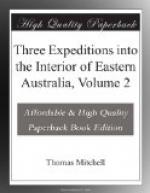(Footnote. Plotosus tandanus see Volume 1.)
Snakes.
On this day’s journey we saw several large snakes; one, large and black, was shot while swimming in a pond in the creek; the others were of that kind named, from the beautifully variegated skin, the carpet snake. The natives considered the latter very fierce and dangerous, saying it never ran away but always faced or pursued them. It had in fact the flat broad head and narrow neck which in general characterise the most venomous snakes, also large fangs hooked inwards, which the natives particularly pointed out. It had also, near the tail, two articulations with something like a toe and joint on each, such as I had not observed before in any other kind of snake. A smaller one of the same kind attacked one of the party, and also a native, but the former shook it from his clothes, it then fixed its teeth in the skin of the native who detached it with difficulty; but as no blood came from the bite he seemed to care little about it. The native name of this place was Cuenbla.
View from Marga.
March 23.
I set off, accompanied by my black guide mounted, for the top of Marga, and we reached it this time by a route in which the native displayed the usual skill of his race. Certainly I never ascended a hill of more perplexing features, all these heights being also of extremely difficult access, very steep and extending in the direction of 10 and 12 degrees East of North. They consist of the sharp edges of inclined strata of hard purple-coloured clay-slate. I was however rewarded for the fatigues this hill had cost me, on two different days, not with a fine view, for the summit was too woody for that, but with a sight of some important points determined during my late journey; and others which I had then observed only from the Canobolas but which I was now enabled to fix by angles observed from this station. The most important point visible besides the Canobolas was Mount Lachlan, by means of which I determined the true situation of Marga and the neighbouring hill Nangar; which is rather higher but more wooded, and 2 1/2 miles distant towards the south-east. These two form the summits of an isolated mountain mass on the left bank of Byrne’s creek, the top of Marga being about 1000 feet above our camp on its banks. I drew outlines (according to my usual custom) of all the hills on the horizon before us, and took angles on them with the theodolite. Descending by a shorter route I reached the camp in time to protract my angles, whereby I ascertained to my great satisfaction that both Marga and Nangar had been truly fixed from the Canobolas, as well as other points observed in my former journey, the accuracy of which, by a good angle with Mount Lachlan, I was thus enabled to prove without going out of my way, besides establishing there a good base for extending the survey southward.
March 24.




